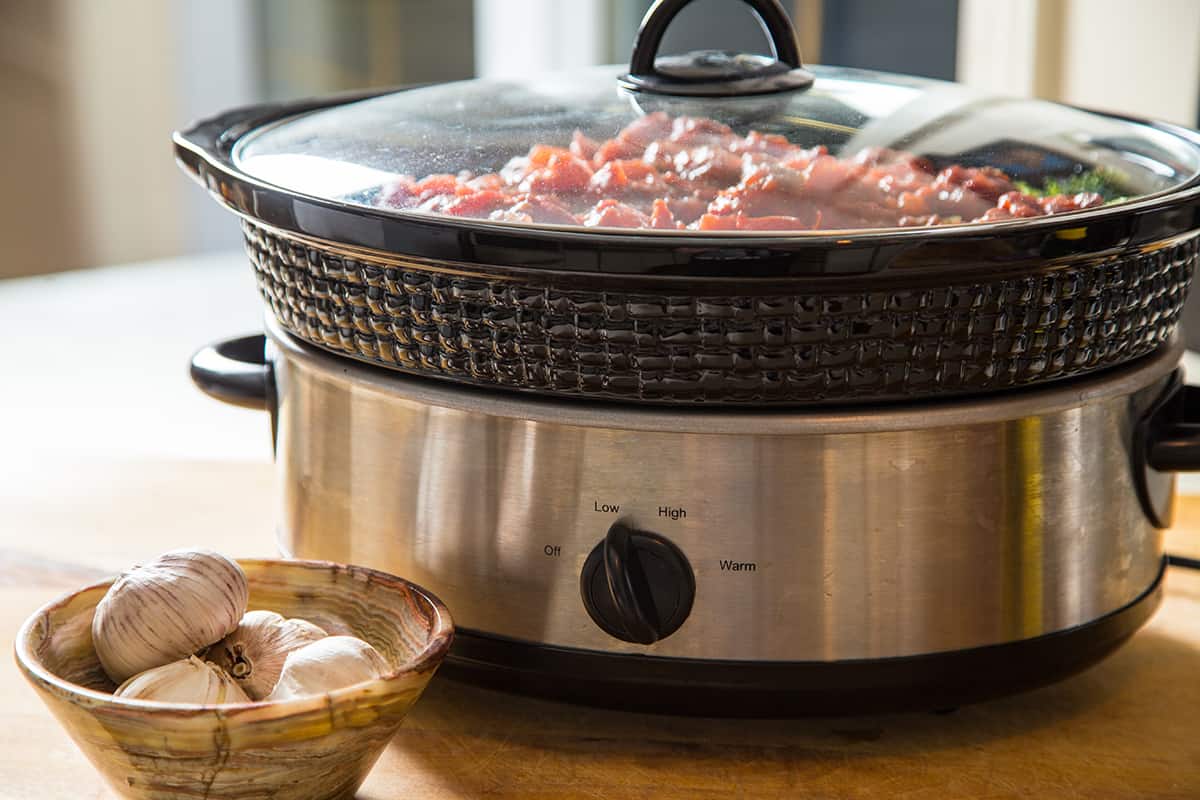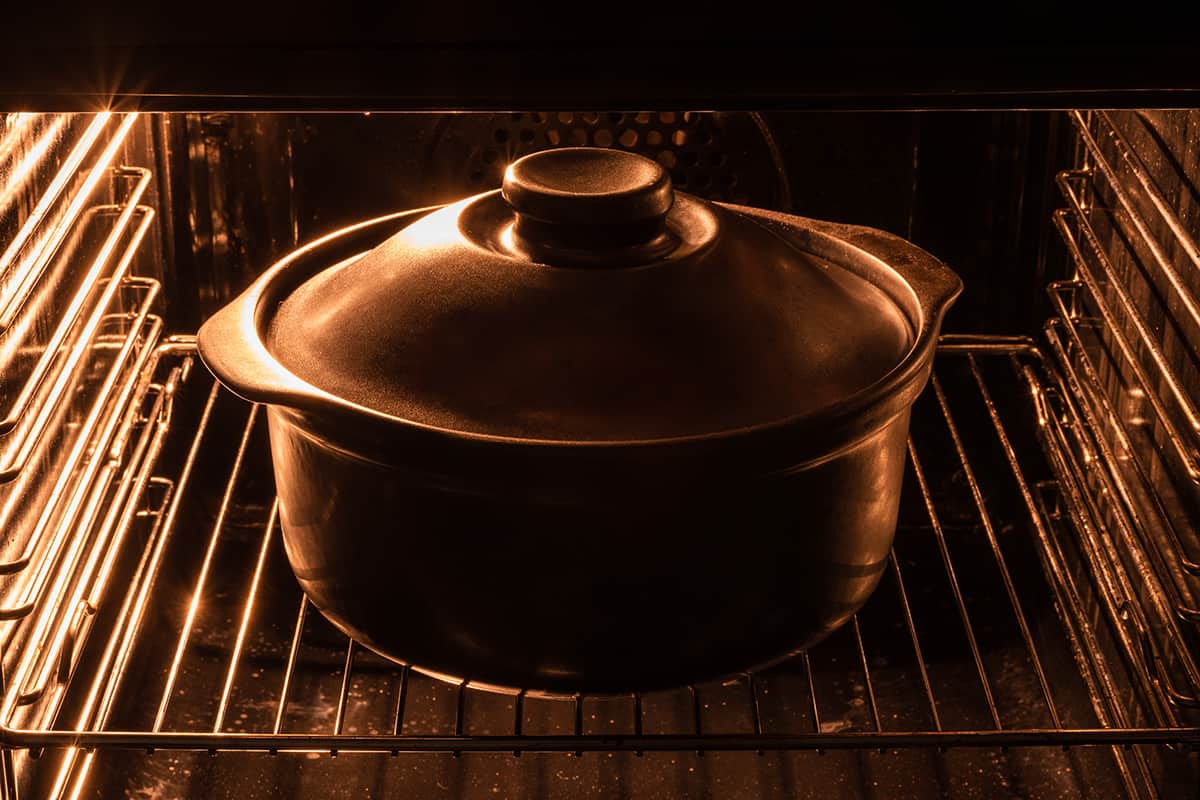There are a ton of fun and tasty dishes you can make with a slow cooker. However, the problem with these dishes is that you need a slow cooker to make them. Or do you? Is it possible to replace a slow cooker with your oven?
Ovens make for an excellent alternative to slow cookers. All you need to use an oven as a slow cooker are an oven-safe baking dish with a lid and plenty of time.
In this guide, I’ll explain what a slow cooker is and how it works, how to use an oven as an alternative to a slow cooker, and what other methods you can try to replicate the slow-cooking process.
What Is a Slow Cooker?

With everyone being so busy nowadays, preparing dinner after a long day at work is a nearly impossible feat. So, is there a regular kitchen appliance you can use to cook your food over a period of 8 to 10 hours without scorching the bottom? Yes, there is—it’s called a slow cooker.
As its name suggests, a slow cooker (a.k.a. a crockpot) is an electronic device that cooks food low and slow. It typically reaches temperatures of between 170 and 280°F, keeping your food out of the danger zone while also breaking down the toughness of rough meats and vegetables. Slow cookers are usually used for making stews, vegetable side dishes, and even delicious cakes.
Slow cookers consist of 3 major components—an outer casting, a lid, and an inner container or bowl.
The outer casting has a built-in heating element on the base and slightly up the side walls. The burner slowly heats the bottom of the inner container to raise the temperature of the cooking liquid, cooking your meats, vegetables, and batter in the process. It’s essential that you keep the lid shut throughout the cooking process, which can take as long as 7 to 10 hours, in order to keep heat from escaping.
Pros and Cons of a Slow Cooker
Now, let’s take a quick look at the ups and downsides of a slow cooker.
Pros
- Automated cooking. Perhaps the greatest benefit of a slow cooker is that it automates the cooking process. All you really need to do is place your ingredients in the pot, turn on the slow cooker, shut the lid, and set the temperature, and you’re all set. You can keep your slow cooker running for extended periods of time (while you’re away at work, for instance).
- Excellent heat control. Slow cookers cook low and slow. As such, you don’t have to worry as much about scorched bottoms as you would with stovetop cooking, grilling, or baking. The lower you set the temperature, the longer you can leave your food unattended without burning.
- Tenderizes tough meats. Tough cuts of meat, including shanks, rounds, and shoulders, need time and heat to break down. While you can break down the proteins in these meat cuts on a stove or in an oven, a slow cooker does it perfectly since it maintains a low temperature for several hours at a time.
- Easy to clean. Nobody likes doing the dishes after preparing an entire meal for the family. With a slow cooker, you only need to remove the food and wash the pot. This becomes a lot easier if you have slow cooker liners, which separate the food from the surface of the pot.
Cons
- Impossible to sear meat. Searing meat adds a crispy layer to the surface of food, creating a delicious contrast of texture in meats and vegetables. However, searing can only be done at temperatures of at least 300°F to produce the Maillard reaction. Since slow cookers max out at 280°F, you’ll have to remove the meat and sear it elsewhere.
- Cannot cook frozen foods. Placing stone-cold meat inside a slow cooker can lead to disastrous effects. Slow cookers slowly raise the temperature of the cooking environment, which can prolong your food’s exposure to the danger zone (40 to 140°F). When using a slow cooker, it’s best to pre-cook the cooking liquid in order to rapidly raise the temperature of your meat. The slow cooker will take care of the rest.
- Power outages can ruin your meal. As an electronic device, slow cookers require a constant flow of electricity to activate the burner. In the event of a power outage that lasts for several hours, the temperature of your food may lower to within the danger zone and be at risk of spoilage.
Can an Oven Be Used as a Slow Cooker?
But what if you don’t have a slow cooker or feel like investing in one? Can you use your oven in place of a slow cooker?
Yes, you can. In fact, there are several benefits to doing this, including even cooking temperatures since the oven’s burner may be built into the side walls. You can also enjoy better heat distribution if you turn on the convection fan.
Here’s what you need to do to use your oven as a slow cooker:
- Turn on your oven to 170 to 180°F if you want to cook for 6 to 10 hours when nobody’s at home. Turn on your oven to 200 to 280°F if you want to eat within 4 hours.
- Place your food in an oven-safe dish with a lid, such as a Dutch oven.
- When the oven has preheated, insert your oven-safe dish into the oven.
- Set the timer (if applicable) to as long as 8 hours, depending on the cooking time.
Most ovens have an auto-shutoff switch that activates after 12 hours. So, even if you forget to set your oven’s timer, the oven has your back.
Other Slow Cooker Alternatives

If you don’t feel comfortable leaving your oven on for extended periods, you can try using the following alternative appliances.
Stovetop
Granted, stovetops can be more dangerous than ovens since the burners are right there for everyone to see. However, with the correct safety precautions, you can cook stews and other liquid-based recipes in a large pot on your stove.
Simply turn the stove on to low heat or its simmering setting. Place your pot filled with cooking liquid onto the stove burner, shut it with a tight-fitting lid, and allow your stew to cook while you’re away. When you get back, sear your meat in a hot skillet with a few tablespoons of oil before serving.
Sous vide machine
Sous vide, which translates to “under vacuum” in French, is a cooking method in which sealed food is placed in a container of heated water. The water is set at a specific temperature (between 125 and 180°F), which slowly cooks and tenderizes the meat.
You can pick the Anova Culinary Sous Vide Precision Cooker to cook your meat while you’re away. One huge benefit of sous vide is that because the temperature of the water never goes beyond 180°F, there’s virtually no risk of burning your food.
The major downside of cooking sous vide is that you have to vacuum-seal your meat, and you can’t cook them in its cooking liquid. Also, you’ll need to sear the meat when you’re done to add flavor and texture, but you’d have to do that with a slow cooker or an oven anyway. In addition, a power outage will interrupt the sous vide process, possibly exposing your food to the danger zone for prolonged periods.
Some people may think that sous vide isn’t a legitimate cooking style, but if it helps you prepare an entire meat-based meal unattended, I say go for it!






